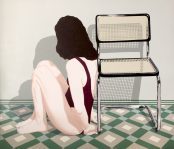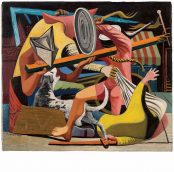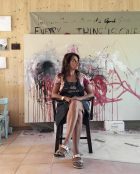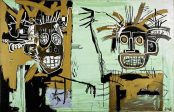[dropcap style=”font-size:100px;color:#992211;”]I[/dropcap]t was Madonna, the iconic goddess of pop, who in a 1990 interview with Vanity Fair stated, “If somebody doesn’t like this painting, then I know they can’t be my friend.” The painting in question was My Birth (1932), a brutal depiction of Frida Kahlo being born or reborn from a body, maybe her mother’s, maybe her own, lying dead on a bed, whilst an adult Kahlo tears into the present moment with a ferocity that permeates her subsequent work. It is this savage beauty that Hettie Judah doesn’t flinch from portraying in her biographical account of the artist.
Kahlo’s practice was surreal before she knew what surrealism was, she was pop before cultivating a public persona was a thing, and created ‘happenings’ way before the 60s, but most of all she was uncompromising in her craft as a female artist. She was also a political tour de force and an avid champion of the new wave of communism that swept Mexico in the early 20th century. Her works were revolutionary, shocking the bourgeois-established artistic milieu not just in content but also in style. She exemplified the primitive, folk art and native surrealism of a pre-Spanish/Catholic world, and echoed the hostility and anger people felt towards the unfolding present.
She is an artist who has become sanitised, commodified and merchandised by an art world eager to diversify income generation. Judah’s book redresses this imbalance with a return to the raw, monstrous energy of Kahlo’s art, taking the artist out of the gift shop and re-establishing her in the gallery. Presenting her practice and the multilayered suffering that informed it in naked realness, she contextualises Kahlo’s life from childhood and family dramas, through her teen years and gender fluidity to the atrocious moment a collision of tram and bus cleaved her body from innocence to womanhood. The result gives a sense of the brutalised rage of a woman torn in two and put back together, of a body capable of providing life and tragically taking it, too.
This wonderful little book reminds the reader that Kahlo is more than a symbol, a trinket in a souvenir shop; Kahlo was the struggle, she was a force of nature. By courageously revealing that which others refuse to show or acknowledge, her work transcends categorisation, challenging through extremes. Judah’s Kahlo reflects Coatlicue, the Aztec goddess of beginnings and endings of life and death, the omnipresent shadow in all her work.
Frida Kahlo: Lives of the Artists is available via Laurence King now.
Image: Frida holding court at the Casa Azul © Frida Kahlo and Diego Rivera Archives. Bank of México, fiduciary in the Diego Rivera and Frida Kahlo Museum Trust
I write short stories and poetry alongside studying religion and anthropology at the University of Manchester. My story “Girl’s World” was in the highly recommended list for the Manchester Fiction prize 2019.




















